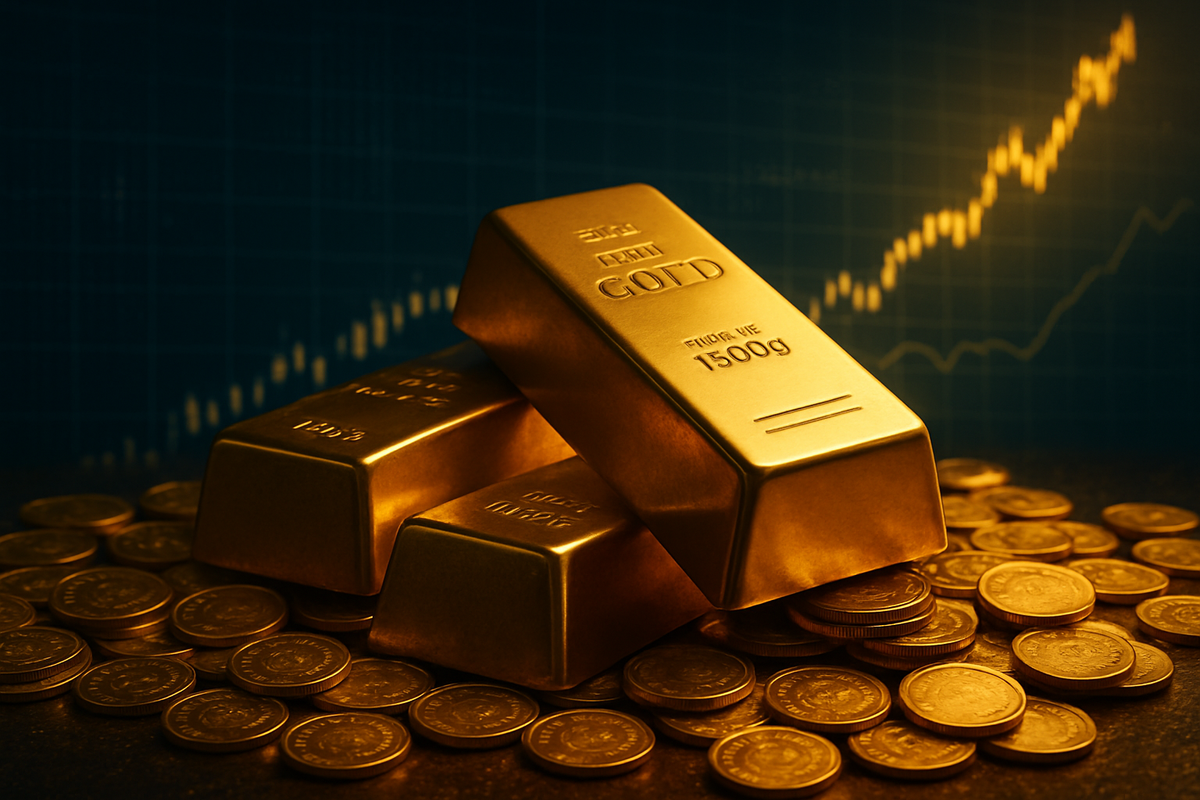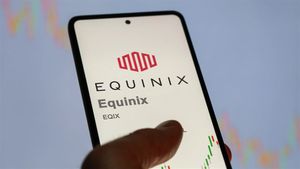
Gold has officially entered a new golden era, with the precious metal's spot price recently shattering all previous records, surging past an unprecedented $3,900 per ounce on October 6, 2025. This historic rally, fueled by a potent mix of global economic uncertainty, persistent inflation concerns, and escalating geopolitical tensions, is sending profound ripples across the financial markets. For the gold mining industry, these record-high prices translate into significantly enhanced profitability and robust cash flows, igniting a wave of optimism and strategic re-evaluation. Investors, meanwhile, are keenly observing gold's reaffirmed status as a premier safe-haven asset and a vital hedge against market volatility, prompting a renewed focus on companies poised to capitalize on this extraordinary surge.
Gold's Unprecedented Ascent: A Timeline of Records and Market Responses
The recent surge in gold prices to unprecedented levels, culminating in spot gold breaking the $3,900 per ounce barrier on October 6, 2025, marks a pivotal moment in financial markets. This remarkable ascent, nearly 50% year-to-date in 2025 following a substantial 27% increase in 2024, is underpinned by a potent combination of factors: escalating safe-haven demand amidst a potential U.S. government shutdown and global growth anxieties, expectations of further interest rate cuts by the U.S. Federal Reserve, and significant currency volatility, particularly with the weakening Japanese yen.
The journey to these record highs has been a steady climb over several years. After a period of consolidation between $1,200 and $1,350 per ounce from 2013-2019, gold began its renewed upward trajectory. It first surpassed $2,000 per ounce in August 2020, then hit a new record settlement price of $2,089.70 in December 2023. The pace accelerated dramatically in 2025, breaking through $2,900/oz in February, $3,000/oz in March, $3,500/oz in April, and steadily climbing past $3,700/oz in mid-September. The final push saw gold breach $3,800/oz on September 30, 2025, and ultimately achieve its all-time high of $3,949.34 intraday on October 6, 2025.
Major gold producers, including industry giants like Newmont Corporation (NYSE: NEM) and Barrick Gold (NYSE: GOLD), are direct beneficiaries of this gold price bonanza. Higher gold prices directly translate into significantly enhanced revenues and improved profit margins, assuming their production costs remain relatively stable. This favorable environment is also spurring increased interest and capital access for smaller exploration and development firms. Notably, the industry is witnessing a leadership transformation, with both Barrick Gold and Newmont Corporation announcing CEO changes on September 29, 2025. This strategic pivot signals a shift from defensive, balance sheet-focused management to more aggressive growth strategies, aiming to capitalize on high gold prices through strategic acquisitions and accelerated development programs.
The broader market reaction to gold's surge has been multifaceted. Central banks globally are accumulating gold at an unprecedented pace, diversifying reserves away from the U.S. dollar, with over 1,000 tonnes purchased in 2024 and robust buying continuing in 2025. Gold-backed Exchange-Traded Funds (ETFs) are experiencing substantial inflows, reaching a record $407 billion in August 2025, reflecting strong investor confidence. The rally has also uplifted other precious metals, with spot silver climbing to a 14-year high of $48.33 and platinum surging by 76% since the start of 2025. While U.S. equity markets have surprisingly held strong, analysts are largely bullish on gold's future, with projections from JPMorgan Research and Goldman Sachs forecasting prices to reach or exceed $4,000 per ounce by late 2025 or mid-2026.
A Golden Opportunity: Top Gold Stocks Poised to Shine
The unprecedented surge in gold prices to over $3,900 per ounce has created a highly lucrative environment for gold mining companies, translating into significantly expanded profit margins and robust cash flows. With all-in sustaining costs (AISC) for many producers averaging between $1,200 and $1,500 per ounce, the current gold price ensures substantial profitability. This sustained rally, driven by a weakening U.S. dollar, persistent geopolitical tensions, and aggressive central bank buying, reinforces gold's critical role as a safe-haven asset and inflation hedge, making select gold stocks particularly attractive.
Newmont Corporation (NYSE: NEM, TSX: NGT), the world's largest gold miner, stands out as a prime beneficiary. Often considered the "blue-chip gold standard," Newmont's scale, diversified Tier 1 assets, and strong financial health position it for exceptional gains. The company has strategically reduced its AISC to $1,593 per ounce in Q2 2025, ensuring high margins. Newmont reported a record $1.7 billion in free cash flow and $2.1 billion in net income in Q2 2025, coupled with a robust balance sheet featuring $6.2 billion in cash and a low net debt-to-adjusted EBITDA ratio of 0.1x. Its stock has surged 85% year-to-date in 2025, with analysts projecting further upside, underscoring its operational efficiency and strategic positioning.
Barrick Gold Corporation (NYSE: GOLD, TSX: ABX), another global mining giant, is also exceptionally well-positioned. With a diversified portfolio and a strong balance sheet, Barrick is accelerating its profitability. The company maintained a stable AISC of $1,050 per ounce in Q1 2025, leading to expanded profit margins of 42%. Barrick boasts significant proven and probable gold reserves of 89 million ounces and has replaced over 180% of its depleted reserves since 2019. Financially, it reported a 34% surge in free cash flow to $876 million in Q1 2025 and has no major debt repayments until 2033, providing ample flexibility for growth and shareholder returns. Jefferies identifies Barrick as a significant "catch-up" play with considerable upside potential.
Agnico Eagle Mines Limited (NYSE: AEM, TSX: AEM) offers investors exposure to a low-cost producer operating in stable jurisdictions. Known for its quality management and minimal geopolitical risk, Agnico Eagle demonstrated strong cost control with an AISC of $1,289 per ounce in Q2 2025. The company achieved 51% of its full-year production target by mid-year, projecting 3.3 to 3.5 million ounces for 2025. Financially, Agnico Eagle reported record adjusted net income of $976 million and free cash flow of $1.3 billion in Q2 2025, transitioning to a net cash position of $963 million. Its robust performance is a testament to its operational efficiency and strategic asset base.
For investors seeking a different approach, royalty and streaming companies like Franco-Nevada Corporation (NYSE: FNV, TSX: FNV) and Wheaton Precious Metals Corp. (NYSE: WPM, TSX: WPM) offer compelling advantages. These companies provide leverage to commodity prices and exploration upside with a lower risk profile, as they avoid direct operational risks and capital expenditures. Franco-Nevada is debt-free, with $1.13 billion cash in hand and generated $289 million in operating cash flow in Q1 2025, boasting an impressive 87.4% adjusted EBITDA margin. Wheaton Precious Metals, similarly debt-free with a $2 billion undrawn credit facility, reported record revenue of $503 million and net earnings of $292 million in Q2 2025, with an adjusted EBITDA margin of 99%, driven by higher metal prices and increased production volumes. Both companies benefit from high-margin business models that thrive in a high-price gold environment, with future growth secured through strategic acquisitions and expanding streaming agreements.
The Broader Implications: Gold as a Barometer of Global Shifts
The relentless ascent of gold prices to record highs, pushing past $3,900 per ounce, transcends mere market speculation; it signifies a profound recalibration in global financial dynamics and investor sentiment. This phenomenon is deeply intertwined with several broader industry trends, creating ripple effects across various sectors, prompting regulatory scrutiny, and echoing historical periods of significant instability. Gold is no longer just a commodity; it's becoming a primary barometer of global uncertainty.
At its core, gold's surge is a testament to its enduring role as a "safe-haven" asset. Persistent inflationary pressures, particularly in major economies, are driving investors to seek refuge in gold as a hedge against currency devaluation and erosion of purchasing power. Simultaneously, an increasingly volatile geopolitical landscape, marked by ongoing conflicts and trade disputes, fuels a pervasive risk premium for the precious metal. The weakening U.S. dollar further enhances gold's attractiveness for international buyers, contributing to robust demand. Perhaps most significantly, the aggressive and sustained gold purchases by central banks globally, exceeding 1,000 tonnes annually for the past three years, signal a strategic move towards de-dollarization and diversification of national reserves in an evolving multipolar world. Expectations of lower real interest rates and dovish monetary policies by central banks also diminish the opportunity cost of holding non-yielding gold, making it more appealing.
The ripple effects of record gold prices are far-reaching. While gold mining companies are experiencing unprecedented profitability, fueling increased exploration and production, they also face the challenge of rising operational costs due, in part, to inflation in equipment, materials, and labor. The jewelry industry, a major consumer of gold, is grappling with higher raw material costs, potentially leading to reduced profit margins and a shift in consumer preferences towards more affordable alternatives or lighter designs. Conversely, the financial sector is seeing gold increasingly integrated into diversified portfolios as a crucial tool for risk reduction. The rally has also extended to other precious metals like silver and platinum, which have seen their own significant price surges, indicating a broader market shift towards hard assets.
From a regulatory and policy standpoint, central banks' gold accumulation is a critical component of their monetary strategies, aimed at hedging against inflation and geopolitical risks. The concerted efforts by various nations to increase gold holdings underscore a strategic pivot away from an over-reliance on the U.S. dollar, potentially accelerating discussions around de-dollarization and the emergence of new currency regimes. Furthermore, apprehension regarding U.S. fiscal policy and political stability, such as potential government shutdowns, can amplify global economic uncertainty, further bolstering gold demand. The heightened market volatility surrounding gold may also prompt discussions about potential regulatory changes or taxation in the gold market, while governments focus on formalizing mining practices to ensure sustainability amidst increased production pressures.
Historically, gold's price movements have mirrored periods of profound economic and geopolitical upheaval. The dramatic surge in the 1970s, culminating in record highs in 1980, was a direct response to rampant inflation and economic instability. Similarly, the aftermath of the 9/11 attacks, the 2008 financial crisis, and the COVID-19 pandemic all saw gold prices climb as investors sought safety. While history often rhymes, the current rally exhibits greater velocity, broader market participation from institutional, retail, and sovereign investors, and more sustained buying pressure than previous surges in 2011 and 2020. This suggests that the current environment, a unique confluence of factors, is amplifying gold's significance, positioning it as a new, potent barometer of global uncertainty.
What Comes Next: Navigating Gold's Enduring Appeal
The trajectory of gold prices and the broader gold market is set to remain a focal point for investors and industry players, driven by a complex interplay of macroeconomic forces, geopolitical shifts, and evolving monetary policies. The prevailing sentiment is overwhelmingly bullish, with both short-term and long-term forecasts pointing towards continued appreciation, though potential challenges and varied scenarios warrant close attention.
In the short term (2024-2025), gold prices are broadly anticipated to maintain their strength, with many financial institutions projecting a stabilization within the $3,500 to $4,000 per ounce range by the end of 2025. Given that spot gold is already trading near or above $3,900 per ounce in early October 2025, the momentum from heightened economic and geopolitical uncertainty, expectations of further interest rate cuts, and robust central bank and ETF inflows is expected to sustain this rally. HSBC and Goldman Sachs, for instance, foresee gold potentially trading above $4,000 per ounce in the near future.
Looking further into the long term (2026-2030 and beyond), the bullish outlook for gold intensifies. JPMorgan Research anticipates prices to average $3,675 per ounce by Q4 2025 and climb towards $4,000 by mid-2026. Goldman Sachs echoes this, expecting gold to exceed $4,000 by mid-2026 and potentially reach $4,300 by the end of that year. More ambitious forecasts from InvestingHaven suggest targets of around $4,200 in 2026 and $4,800 in 2027, with a peak prediction of $5,155 by 2030. Some experts even speculate about gold reaching $7,000 per ounce by 2030, driven by persistent inflation, ongoing geopolitical tensions, and the continued strategic accumulation by central banks.
For gold mining companies, this environment necessitates strategic pivots and adaptations. Operational efficiency and stringent cost management will be paramount to counter potential inflationary pressures on equipment and labor. With declining discovery rates of new major gold deposits, advanced exploration technologies and robust reserve management will be crucial for long-term supply. Companies will also need to focus on geographical diversification to mitigate political risks and prioritize sustainability and ESG initiatives to meet increasing scrutiny over environmental impact. Technological innovation, including AI, automation, and blockchain for ethical sourcing, will define the industry's future. Furthermore, strategic partnerships and mergers & acquisitions will offer flexible financing and operational leverage to navigate the evolving landscape.
Emerging market opportunities are significant, fueled by continued strong investment demand in gold ETFs, physical bullion, and gold mining equities, alongside the sustained central bank diversification away from the U.S. dollar. Growth in emerging markets like China and India will also continue to underpin demand. However, challenges persist, such as shifts in monetary policy, a significant easing of geopolitical tensions, and environmental and regulatory pressures.
Potential scenarios range from a continued bullish rally, driven by persistent inflation and escalating conflicts, which could see gold surpass $5,000, to a short-term correction if geopolitical tensions ease or the U.S. dollar strengthens. A stagflationary environment, characterized by slow growth and high inflation, would be particularly bullish for gold. While a sideways or moderate growth scenario is possible, the current backdrop of global uncertainties makes a sustained rally or even a short-term correction more likely. Gold's role as a hedge against uncertainty and a strategic asset ensures its prominence in the coming months and years.
The Golden Horizon: A Resilient Market and What Lies Ahead
Gold's unprecedented surge to record highs in 2025, with spot prices reaching approximately $3,910 per ounce by early October, represents a nearly 50% increase year-to-date, building on a significant 27% rise in 2024. This remarkable performance is not merely a fleeting market anomaly but a profound reflection of a "perfect storm" of economic, geopolitical, and market factors that have fundamentally reshaped investor behavior and global financial strategies.
The key takeaways from this historic rally are multifaceted. Firstly, escalating geopolitical tensions, from ongoing conflicts to trade disputes and political transitions, have unequivocally reinforced gold's role as the quintessential safe-haven asset. Investors are actively diversifying away from riskier holdings, seeking gold as a bulwark against global instability. Secondly, the anticipation of Federal Reserve interest rate cuts, coupled with a broader shift towards accommodative central bank policies, has made non-yielding assets like gold more attractive by reducing their opportunity cost. Thirdly, a weakening U.S. dollar, alongside an accelerating de-dollarization trend driven by emerging market central banks diversifying their reserves, provides robust structural support for gold prices. Finally, persistent inflation, economic uncertainties, and government fiscal challenges continue to fuel demand for gold as a proven hedge against eroding purchasing power and market anxiety.
Moving forward, the market outlook for gold remains decidedly bullish through 2025 and 2026. Major institutions like J.P. Morgan Research, Goldman Sachs Research, and UBS all project gold to average around $3,700-$3,900 per ounce by late 2025, with many forecasting a climb towards or beyond $4,000 by mid-2026. Some even suggest prices could reach $5,000 or higher by 2030, driven by the continued structural demand from central banks and potential easing from the Federal Reserve. This bullish sentiment is underpinned by gold's effectiveness as a hedge against stagflation, recession, currency debasement, and U.S. policy risks. While potential headwinds exist, such as fewer-than-expected interest rate cuts or a resurgence in U.S. dollar strength, the prevailing narrative points to a sustained elevated price environment.
The lasting impact of this gold rally signifies a deeper erosion of confidence in traditional financial instruments and fiat currencies, re-emphasizing gold's critical function as a trusted store of value. It also underscores an accelerating de-dollarization trend, which could have significant long-term implications for the international monetary system. For investors, this translates into a structural bull market for gold, driven by fundamental shifts rather than purely cyclical factors.
In the coming months, investors should vigilantly monitor several key indicators. Signals from the U.S. Federal Reserve regarding interest rate decisions and future policy will be paramount. Ongoing geopolitical developments, U.S. economic data, and political stability will continue to influence safe-haven demand. The performance of the U.S. dollar, central bank gold purchases, ETF flows, and physical demand from major markets like China and India will also provide crucial insights. Finally, persistent inflation trends will continue to bolster gold's appeal. Gold's recent record-breaking performance is a testament to its enduring relevance in an increasingly complex and uncertain global landscape, solidifying its position as a cornerstone of diversified portfolios.
This content is intended for informational purposes only and is not financial advice






